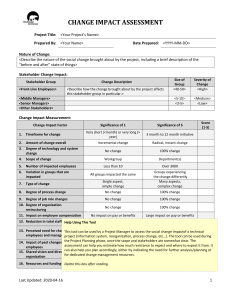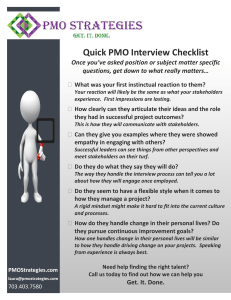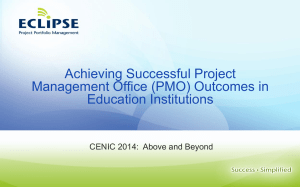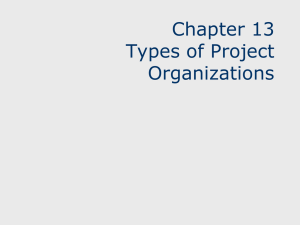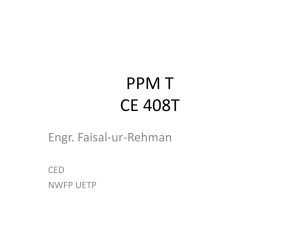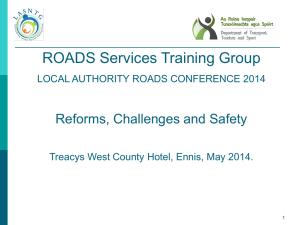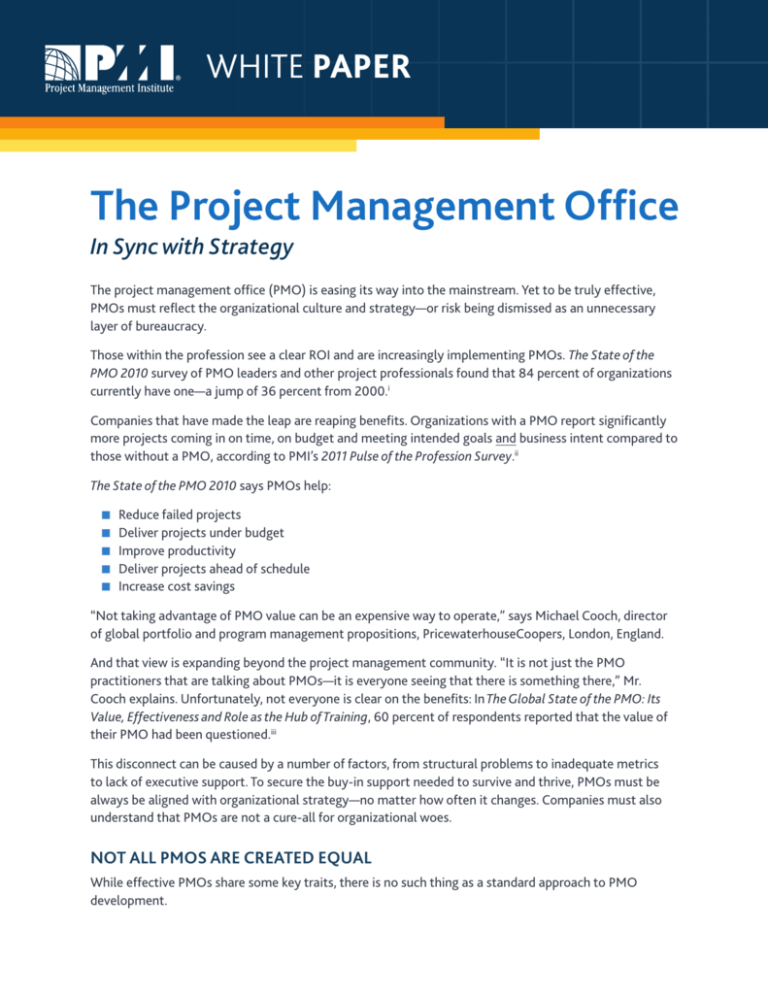
The Project Management Office
WHITE PAPER
The Project Management Office
In Sync with Strategy
The project management office (PMO) is easing its way into the mainstream. Yet to be truly effective,
PMOs must reflect the organizational culture and strategy—or risk being dismissed as an unnecessary
layer of bureaucracy.
Those within the profession see a clear ROI and are increasingly implementing PMOs. The State of the
PMO 2010 survey of PMO leaders and other project professionals found that 84 percent of organizations
currently have one—a jump of 36 percent from 2000.i
Companies that have made the leap are reaping benefits. Organizations with a PMO report significantly
more projects coming in on time, on budget and meeting intended goals and business intent compared to
those without a PMO, according to PMI’s 2011 Pulse of the Profession Survey.ii
The State of the PMO 2010 says PMOs help:
■■
■■
■■
■■
■■
Reduce failed projects
Deliver projects under budget
Improve productivity
Deliver projects ahead of schedule
Increase cost savings
“Not taking advantage of PMO value can be an expensive way to operate,” says Michael Cooch, director
of global portfolio and program management propositions, PricewaterhouseCoopers, London, England.
And that view is expanding beyond the project management community. “It is not just the PMO
practitioners that are talking about PMOs—it is everyone seeing that there is something there,” Mr.
Cooch explains. Unfortunately, not everyone is clear on the benefits: In The Global State of the PMO: Its
Value, Effectiveness and Role as the Hub of Training, 60 percent of respondents reported that the value of
their PMO had been questioned.iii
This disconnect can be caused by a number of factors, from structural problems to inadequate metrics
to lack of executive support. To secure the buy-in support needed to survive and thrive, PMOs must be
always be aligned with organizational strategy—no matter how often it changes. Companies must also
understand that PMOs are not a cure-all for organizational woes.
NOT ALL PMOS ARE CREATED EQUAL
While effective PMOs share some key traits, there is no such thing as a standard approach to PMO
development.
The Project Management Office
There are multiple ways to classify PMOs, says Monique Aubry, PhD, professor, graduate programs in
project management, School of Business and Management, University of Québec at Montréal, Québec,
Canada. PMOs can vary based on their organizational context, structural characteristics (such as where
the PMO is located within the organization), and roles or functions.
These factors mean PMOs can differ greatly from organization to organization. What they all must have
in common, however, is a strong foundation to help them weather the precarious early stages of the
PMO’s launch.
Mr. Cooch estimates half of PMOs fail on their first attempt because they do not align with
organizational strategy. For instance, a company might set up its PMO success criteria around budget,
when the organization’s overall focus is innovation. At IT giant Google, for example, delivering costeffective and timely projects is important, but not as important as coming up with cutting-edge thought
leadership. “The PMO has to have an environment where ideas can be created,” he says. Sometimes that
means the budget and schedule are lower priorities.
Understanding a company’s key drivers is the only way PMOs will contribute value, Mr. Cooch explains.
“You have to be flexible... You really have to understand the market
and the organizational archetypes you are working in. How does
organizational strategy tie into your strategy?”
–– Michael Cooch, director of global portfolio and program management propositions,
PricewaterhouseCoopers, London, England
PMOs vary by organization, but establishing the necessary processes and culture does not require
starting from scratch each time. “I do not believe PMO leaders need to consider themselves unique in the
world of leadership or fostering a culture of success” says Mr. Cooch.
Mr. Cooch suggests all PMO leaders:
1. Err on the side of collaboration over policing to boost support and longevity.
2. Secure executive buy-in so the PMO’s value is understood by the whole organization.
3. Ensure every member of the PMO team understands his or her individual value and the value of the
PMO as a whole.
One of the top differentiators of success is how well a PMO is embedded within an organization, Dr.
Aubry says. She lists four factors that determine this level of integration:
1. Collaboration: The PMO should encourage collaboration between project professionals and
functional departments.
2
The Project Management Office
2. Recognition of expertise: Do the project professionals working with the PMO improve the level of
respect project management receives within the organization? This should also influence who works
in the PMO.
3. The mission is well understood: Do those outside the PMO know its purpose?
4. Support from upper management: Is there an executive champion who will not only communicate
the mission, but will work to gain engagement from stakeholders?
“Increasing the intensity of one or more of these variables should increase the level of embedding and,
consequently, the PMO performance,” says Dr. Aubry. “The organization needs to put emphasis on these
elements that are often put aside, rather than taking care only of technical facets of the PMO’s functions
and characteristics.”
PMO IN ACTION
The Organization:
The Sector:
The ROI:
State Auto, Columbus, Ohio, USA
Insurance
By focusing on outcomes rather than processes, State Auto’s reorganized
PMO nearly tripled the number of projects that deliver on organizational
strategy.
The PMO at State Auto was operating in a vacuum. Small, random projects would pop up, with no
consistent mechanism system to ensure projects were meeting strategic objectives, staying on budget
and sticking to their original goals.
Realizing it had to make major changes, the company put the PMO in charge of delivery, methodology,
governance, project portfolio management and change management for enterprise-wide projects.
State Auto’s overall strategy is now revisited each year, and once a month, the PMO team analyzes how it
is driving that vision through projects.
Organizational units looking to launch projects are now required to build a business case that details
how they align with corporate strategy. Also, teams are now required to complete project scorecards to
demonstrate this alignment.
“Strategy without execution is hallucination... You can develop
strategy, but if you cannot execute it, you can just throw it away.”
–– Greg Ramah, State Auto’s project portfolio management director
Getting to that point has been a multi-year process for State Auto. Mr. Ramah overhauled the PMO team
in 2009, replacing a team staffed primarily by those with an insurance background.
3
The Project Management Office
“I brought in people who understand what makes projects work, what makes
project fail... If PMOs are not staffed well, they won’t understand this.”
–– Greg Ramah, State Auto’s project portfolio management director
The PMO team spent time with executives and stakeholders, including project managers and subject
matter experts, to discuss the value of the PMO, its goals and its methodologies.
Mr. Ramah and his team began by working with business units enthusiastic about the PMO’s changes,
including IT and claims. “We brought them in early and really talked to them about what they wanted to
accomplish and how it meshed with what we wanted to accomplish,” Mr. Ramah says. Those unites were
then transformed into promoters for the PMO throughout the organization. “Once they see success, they
want to be involved.”
Not all of State Auto’s business units have been keen on its PMO’s new approach. Now that they can no
longer just launch a project, says Mr. Ramah, some view it as a constraint. But the PMO team continues
to work with reluctant units to bridge that gap, helping them realize the added strategic value of teaming
with the PMO.
The PMO’s efforts are having an impact. Now 90 percent of State Auto’s projects are tracked within the
PMO, Mr. Ramah reports, and a majority will be directly aligned to business strategies by the end of 2012.
SEEING VALUE
Perhaps the biggest obstacle facing PMOs is not delivering results, but communicating them upward.
Only 15 percent of project managers who report to vice presidents of IT believed their firm recognizes the
PMO as delivering significant value, according to The State of the PMO in 2011.iv That number increases
slightly, to 22 percent, when respondents report to a CIO. And nearly 70 percent of respondents to
the Global State of the PMO Study who said that their PMO’s value was questioned said that it was
senior management who was skeptical. Those questions often are due to a lack of project management
understanding in the upper ranks.
“Why do some organizations see the value of PMOs? This is directly
related to the project management maturity of its leaders, not just the
size of the organization.
–– Eric Morfin, PMP, senior director of the oncology business unit at Pfizer, La Jolla, California, USA
“I have worked with large companies with very immature leadership and smaller organizations with very
mature leaders,” Mr. Morfin says. “If the executive is not mature or familiar with PMOs, at least that
person needs to be smart enough to hire the best PMO leader and let him or her establish the processes
and culture to make a difference.”
4
The Project Management Office
Executives must first establish the value of project management in delivering strategic results. With that
foundation, they can then spread the word about why the organization needs a PMO. They should secure
funding, get buy-in from different departments, and create a value proposition. “That will happen with
the executive support,” Raed Skaf, PMP, executive manager of PMO and budgeting at Mobily, Riyadh,
Saudi Arabia.
Attention from the executive suite can go a long way, Mr. Morfin says. But because it can take anywhere
from eight to 15 months to show benefits, executives must be ready, willing and able to support and
protect the PMO staff in the interim.
“By following the PMO processes and guidelines, executives will provide
credibility to the whole process and to the PMO itself.”
–– Eric Morfin, PMP, senior director of the oncology business unit at Pfizer, La Jolla, California, USA
Once the PMO finds its rhythm, executives must continue to offer support—but learn when to step back.
“A high level of executive involvement in the committees or in the decisions made by the PMO will often
lead to constant changes, frustration and a sense that the PMO is only another fad that will pass with
time,” Mr. Morfin says.
PMO IN ACTION
The Organization:
The Sector:
The ROI:
National Cancer Institute (NCI), Bethesda, Maryland, USA
Healthcare
Evaluating its processes helps a PMO reduce project planning time by 75
percent.
To maximize the value of a PMO, project management leaders must not only analyze organizational
processes—they must be willing to make necessary changes.
Pfizer’s Mr. Morfin dove into NCI’s project management processes while working as head of its PMO in
2010. He found that teams working on early-phase drug-development projects started each project plan
from scratch, even though there was significant overlap across all of them.
“When you look at the activities in a work breakdown structure for any cancer project and compare
(them) with other cancer projects, you will find that 80 percent of the activities will be the same from
one project to another one,” he says. “It does not mean all the parameters for these activities will be the
same, like duration or cost, but the activities and the type of work are identical or very similar.”
To streamline the process and end duplication, Mr. Morfin worked with the PMO to design, implement
and manage a phase-gate process that incorporates project management, design control and process
management practices. Under the old system, teams would participate in 16 four-hour meetings to create
a project plan. Now, it takes only four meetings—a 75 percent reduction.
5
The Project Management Office
“The main goal of the institute was to become more efficient in its use
of all resources—people and financial... Additional benefits were to
provide a greater level of transparency to the use of government and
other grants by providing a clear selection process and up-to-date
information.”
–– Eric Morfin, PMP, senior director of the oncology business unit at Pfizer, La Jolla, California, USA
To make those changes, the PMO team had to overcome the status quo. The deputy director of NCI
was willing to stand by the PMO and had faith in trying new approaches and methods. “That made
overcoming resistance much easier than anticipated,” he says. “As the leader of the group, others
followed and respected his decisions.”
Another issue: the desire of middle managers and other department heads to control the PMO to
advance their own agendas, which had very little to do with bringing in efficiencies, Mr. Morfin explains.
“The only way to address these behaviors was to systematically bring them up to the top leaders and
have them restate the vision and goals.”
WATCH IT GROW
A PMO’s development is never done; it must continue to mature, grow and evolve to deliver value to
organizations. “There is this kind of complacency that can set in,” says Mr. Cooch. “But you’ve got to keep
yourself on your toes. Do not pull out of the race too early. Never stop improving.”
PMOs should implement periodic assessments to ensure strength and improvement areas are clearly
identified. “I bring in my assurance colleagues at least every six months to run a full health check on my
programs,” he says.
Organizations should also provide PMO leaders with ongoing training and encourage them to take
advantage of networking opportunities to improve their skill sets.
That kind of growth heightens the PMO’s capabilities, which in turn boosts results. According to The State
of the PMO 2010, advanced PMOs are far more likely to meet critical success factors, reduce the number
of failed projects, and demonstrate significantly greater improvements in the areas of cost savings and
on-schedule delivery.
One key differentiator of capability is the number and type of roles that comprise the PMO. The survey
found that more developed PMOs were almost twice as likely to have a metrics analyst, “because being
appreciated for adding value is at least partially due to measuring the value that you add,” the report
says. Advanced PMOs were also more likely to have bigger budgets and perform portfolio management,
training and development functions.
6
The Project Management Office
“Ultimately, the PMO needs to be the driving force shaping the
organization’s project management culture. It means that the PMO will
often be suggesting changes to the overall organizational culture to
ensure that the efficiencies keep being delivered.”
–– Eric Morfin, PMP, senior director of the oncology business unit at Pfizer, La Jolla, California, USA
Another sign of a PMO’s capabilities is how well it adapts to organizational strategy shifts that are driven
by business trends. “The educated PMO should be able to evolve before everyone else,” says Mr. Cooch. If
the market starts to decline, for example, PMO team members should be able to recommend whether or
not the project portfolio needs to be trimmed, or whether or not the defined success criteria need to be
altered.
“They need to be at the forefront of identifying and responding to trends. It becomes that value-added
function. If a PMO can become that trusted adviser and align itself to strategy, it will succeed,” says Mr.
Cooch. “If not, you are already heading down the wrong path.”
Dr. Aubry says it comes down to adaptability. “When we implement a PMO we should always think about
change,” she says. “It will change. It’s normal to change.”
But those changes should be communicated to executives and stakeholders in way that will not give
ammunition to skeptics. “Agility, in the case of PMO design, is the capacity to adapt and evolve. To be
agile, a change in a PMO should not be communicated as something was ‘wrong’ with the PMO, and now
we have it right,” Dr. Aubry says. Instead, organizations should provide reasons for the change and the
benefits, while reinforcing the transitional nature of the PMO.
Being flexible with process is one way organizations can deal with change. “Not all projects are the
same size or degree. You have to be able to move quickly on some projects. If you cannot scale, you are
pigeonholing yourself,” Mr. Ramah says. In some cases, unwavering adherence to process can cause a
critical delay in time to market, for example. Instead, process should adapt and be monitored with checks
and balances.
“Crushing your people with process will alienate you, and you’ll find the PMO measures of success do not
align with those of the project and program leads.” says Mr. Cooch. PMO leaders should start small and
focus on the project manager’s needs. Producing a scorecard, for example, can give them insight into a
project that they have not had before.
7
The Project Management Office
“...As your PMO process framework widens, you should be trying to
reduce the administrative burden at roughly the same rate. Same
effort, less administration, more insight... We are evolving the PMO,
across the board, beyond administrative and tactical functions to
critical strategic entities.”
–– Michael Cooch, director of global portfolio and program management propositions,
PricewaterhouseCoopers, London, England
SUMMARY
As the number of PMOs increase, so do expectations. No longer is it enough to simply lead governance
or monitor methodology. Instead, PMOs must provide tangible, repeatable, long-term benefits. To do so,
they must be customized from the start to align with organizational strategy and be prepared to change
as corporate strategy shifts.
Furthermore, it is not enough for PMOs to produce results. They must also communicate those results
throughout their organization to earn executive support and overcome skepticism. Only by doing so will
PMOs be viewed as offering a competitive edge.
i. The State of the PMO 2010, PM Solutions. Results based on more than 290 respondents from around
the world and across a variety of industries, including PMO leaders, team members, project and program
managers.
ii. 2011 Pulse of the Profession, Project Management Institute. Results based on a survey of more than
1,000 PMI members and credential holders.
iii.The Global State of the PMO: Its Value, Effectiveness and Role as the Hub of Training, ESI, March 2011.
Results based on a survey of more than 3,700 respondents from around the world.
iv.The State of the PMO in 2011, Forrester Research. Results based on an online survey of 693 PMO leaders
conducted from April to May 2011 in conjunction with PMI’s Program Management Office Community of
Practice.
8
© 2012 Project Management Institute, Inc. All rights reserved. “PMI” and the PMI logo are marks of Project Management Institute, Inc.
For a comprehensive list of PMI marks, contact the PMI Legal Department. ORG-17007-2012(03-12)

